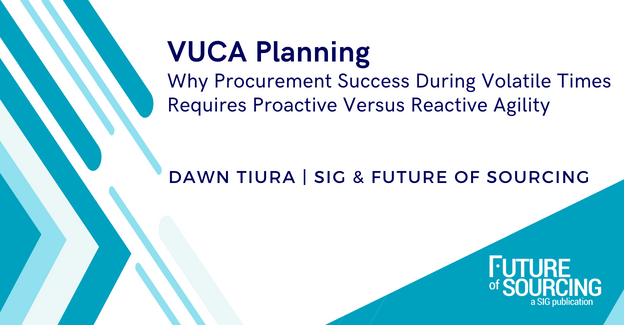VUCA Planning: Why Procurement Success During Volatile Times Requires Proactive Versus Reactive Agility
Agility is not a reflex action (or reaction). Instead — through proactive activities such as building stronger and more collaborative relationships with suppliers, procurement departments can quickly pivot to meet an issue, says Dawn Tiura, CEO and President of SIG, SIG University and Future of Sourcing Digital Publication.
What does it mean to have an agile supply chain?
The above question has been raised countless times since the pandemic's beginning, as most supply chains were “stretched” beyond the breaking point.
But during times of Volatility, Uncertainty, Complexity and Ambiguity (VUCA), we should ask this: is the agility to which I refer "proactive or reactive?"
Planning Agility?
In a previous article on how “improving supply chain relationships can increase profitability in an inflationary market,” references were made to accidental agility and having the ability to pivot.
When it comes to being agile, it is clear the agility to respond or adapt to challenging situations doesn’t happen by accident. In other words, agility is not a reflex action (or reaction). Instead – through proactive activities such as building stronger and more collaborative relationships with suppliers, procurement departments can quickly pivot to meet an issue.
It sounds good, doesn't it? But what does it mean to be proactively agile, and how do you do it?
Don’t Optimize, Build
I recently came across several interesting LinkedIn discussions about volatility and black swan events and how procurement had to react better to the dynamics of an ever-changing world.
Those responding to the post raised many excellent points. However, one comment seemed to strike a resonating note with the author of one of the posts.
Referencing a famous tweet by Box CEO Aaron Levie in which he said that we should always be "building for how the world *should* work instead of optimizing for how the world *does* work," the commenter stated that Levie was really talking about having a proactive versus reactive agility.
Let’s face it, the world of work is constantly changing. I agree with that statement. The pandemic has forced us to confront a very different reality from the one with which we were familiar and, to a certain degree, comfortable. While acknowledging the pandemic was a “generational event” and that with black swan events, there will always be a reactive element to any response, you can significantly minimize the potential negative impact by getting ahead of the curve.
Getting Ahead of the Curve
So, how do you minimize the impact of an unexpected event?
It starts with having an "ahead-of-the-curve readiness."
Citing a well-known case study of what they called a "localized" catastrophe, the comment's writer referenced a notable article about Nokia and Ericsson. According to the post, Nokia's ability to respond was much better than Ericsson’s after "lighting struck a Philips microchip plant in New Mexico, causing a fire that contaminated millions of mobile phone chips?"
Even though neither company could predict a lightning strike (who could), Nokia's supply-chain management strategy allowed it to switch suppliers quickly. In fact, the company was even in the position to "re-engineer some of its phones to accept both American and Japanese chips, which meant its production line was relatively unaffected.”
To suggest that Nokia’s agility was spontaneous or accidental would likely be a mistake. Instead, the company’s ability to adapt had more to do with having a proactive versus reactive agility mindset. In other words, they were ahead of the curve in their thinking. As a result, their response to an external event in which the origin was not in their control was swift and effective.
Rather than try and ride it out like Ericsson, Nokia had a better state of readiness because the latter built its capabilities for how the world should (and needed to) work and thus avoided the trap of familiarity and complacency with how it did work.
A Big Payoff
What are the rewards of having a proactive versus reactive agility mindset?
In Nokia’s case, their profits rose by 42% the year of the lightning strike.
As for Ericsson, during the same period, the company lost “more than US $400 m in annual earnings,” and with it, significant market share.
What is your state of agile readiness during these uncertain times?









